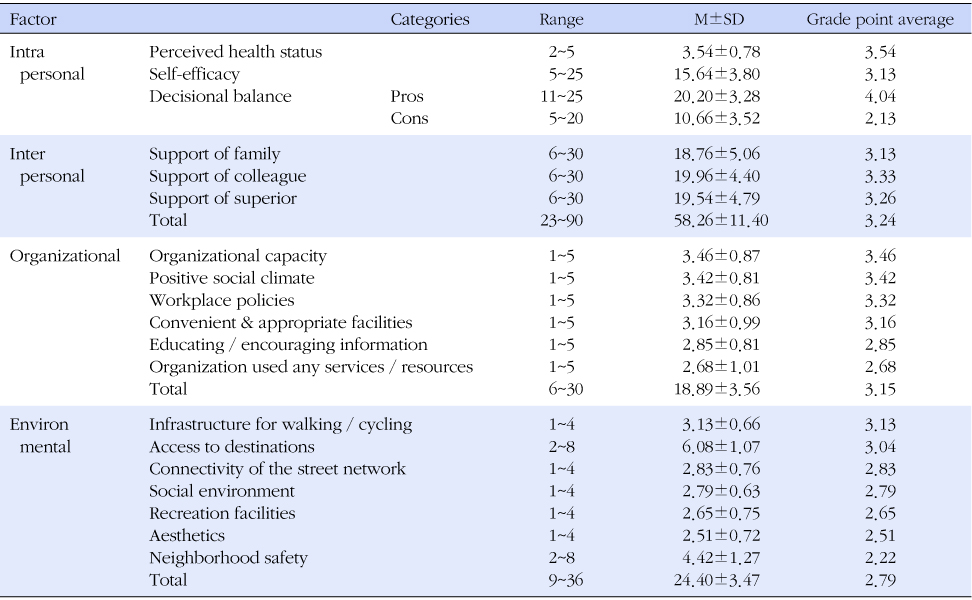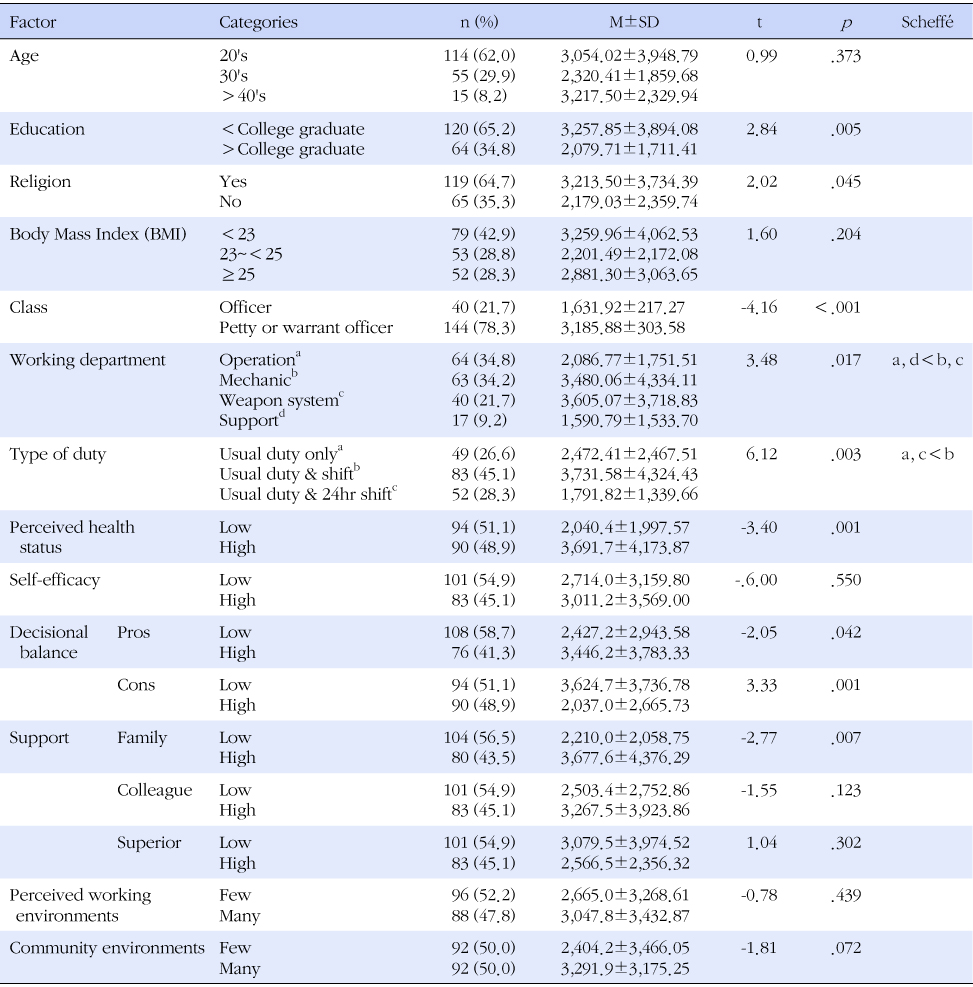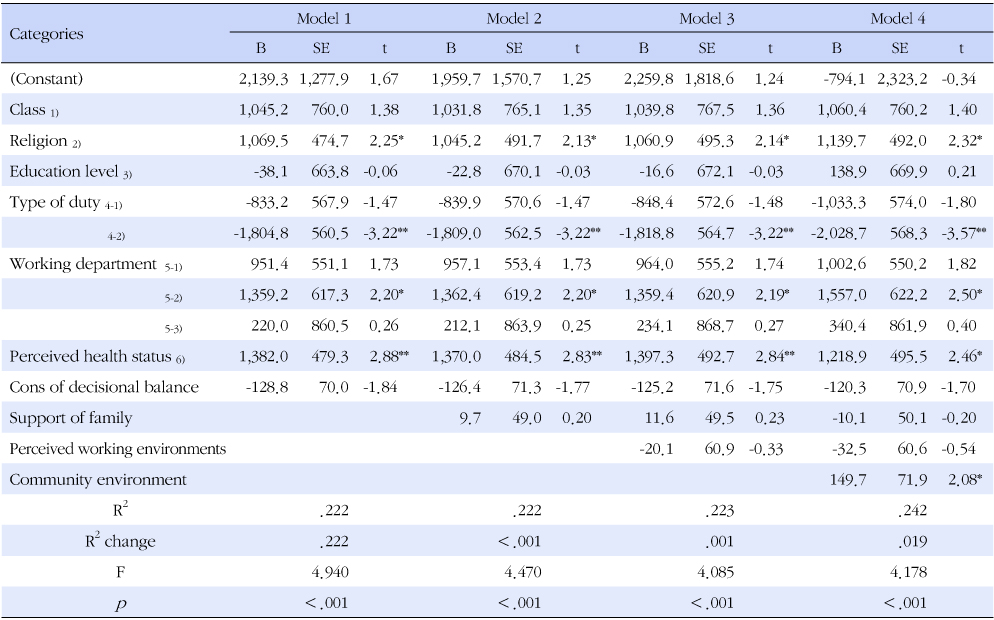References
1. Beresford SA, Bishop SK, Brunner NL, Duncan GE, McGregor BA, McLerran DF, et al. Environmental assessment at worksites after a multilevel intervention to promote activity and changes in eating: The PACE project. Journal of occupational and environmental medicine 2010. 52Suppl 1. S22–S28.
2. Bohnker BK. Analysis of navy physical evaluation board diagnosis. Military Medicine 2003. 168(6)482.
4. Choi JA. Construction of leisure physical activity model in middle-aged women 2005. Seoul: Seoul University; Unpublished doctoral dissertation.
5. Cho JH, Kang BM. Determinants of physical activity in environmental and social factor: A review. Korean Society for Measurement and Evaluation in Physical Education and Sports Science 2009. 11(3)87–104.
6. Craig CL, Marshall AL, Sjostrom M, Bauman AE, Booth ML, Ainsworth BE, et al. International physical activity questionnaire: 12-country reliability and validity. Medicine & Science in Sports & Exercise 2003. 35(8)1381–1395.
7. De Bourdeaudhuij I, Sallis JF, Saelens BE. Environmental correlates of physical activity in a sample of Belgian adults. American Journal of Health Promotion 2003. 18(1)83–92.
8. Gauvin L, Levesque L, Richard L. In : Singer RN, Hausenblas HA, Janelle CM, eds. Helping people initiate and maintain a more ctive lifestyle: A public health framework for physical activity promotion research. Handbook of Sport Psychology 2001. New York: John Wiley & Sons; 718–739.
9. Han KH, Song JE. Health and family-work role characteristics of middle aged men in Korea. Family and Culture 2001. 13(1)51–73.
10. International Physical Activity Questionnaire Core Group. Guidelines for data processing and analysis of the International Physical Activity Questionnaire (IPAQ): Short and long forms 2005. Retrieved December 28, 2011. from
http://www.ipaq.ki.se/scoring.pdf.
11. Jun SH, Jeong ES, Ha HD, Kim JG, Lee SH. Research on the sick and wounded of seafarers and medical support system 2006. In : Paper presented at the meeting of the Korean Institute of Navigation and Port Research Conference. Seoul, Korea.
12. Ku HJ, Lee DT. Estimation of physical activity levels using International Physical Activity Questionnaires (IPAQ) in Korean college students. Journal of Sports Science Research 2006. 2465–73.
13. Lim DS. A study on the health concept, health promotion and practices behaviors of some soldiers: Focused of nurse officers 2005. Seoul: Kyung Hee University; Unpublished master's thesis.
14. Marcus BH, Selby VC, Niaura RS, Rossi JS. Self-efficacy and the stages of exercise behavior change. Research Quarterly for Exercise and Sport 1992. 6360–66.
15. McEachan BR, Lawton RJ, Jackson C, Conner M, Meads D, West R. Testing a workplace physical activity intervention: A cluster randomized controlled trial. International Journal of Behavioral Nutrition and Physical Activity 2011. 8(29)1–12.
16. McLeroy KR, Bibeau D, Steckler A, Glanz K. An ecological perspective on health promotion programs. Health Education Quarterly 1988. 15(4)351–377.
17. Ministry of Health and Welfare. Health plan 2020 2011. Seoul: Author;
18. Ministry of National Defense & Catholic University. Health promotion system and model development of the military 2009. Seoul: Author;
19. Mota J, Almeida M, Santos P, Ribeiro JC. Perceived neighborhood environments and physical activity in adolescents. Preventive Medicine 2005. 41834–836.
20. Nigg CR, Rossi JS, Norman GJ, Benisovich SV. Structure of decisional balance for exercise adaptation. Annals of Behavioral Medicines 1998. 20S211.
21. Oh JY, Yang YJ, Kim BS, Kang JH. Validity and reliability of Korean version of International Physical Activity Questionnaire short form. Journal of Korean Academy of Family Medicine 2007. 28(7)532–541.
22. Prodaniuk TR, Plotnikoff RC, Spence JC, Wilson PM. The influence of self-efficacy and outcome expectations on the relationship between perceived environment and physical activity in the workplace. International Journal of Behavioral Nutrition and Physical Activity 2004. 1(1)7.
23. Saelens BE, Sallis JF, Black JB, Chen D. Neighborhood-based differences in physical activity: An environment scale evaluation. American Journal of Public Health 2003. 93(9)1552–1558.
24. Sallis JF, Bowles HR, Bauman A, Ainsworth E, Bull FC, Craig CL, et al. Neighborhood environments and physical activity among adults in 11 countries. American Journal of Preventive Medicine 2009. 36(6)484–490.
25. Sallis JF, Grossman RM, Pinski RB, Patterson TL, Nader PR. The development of scales to measure social support for diet and exercise behaviors. Preventive Medicine 1987. 16825–836.
26. Seo GS. The patterns and related factors of exercise behavior changes of workers 2006. Daejeon: Chungnam National University; Unpublished doctoral dissertation.
28. Shanas E. The health of older people: A social survey 1962. Cambridge: Harvard University Press;
30. Yoo HJ, Lee JS. The research regarding the effect where the long period sailing goes made to a physical strength and that alternative. Oceanic Research Collection of Treatises 2002. 29369–387.



